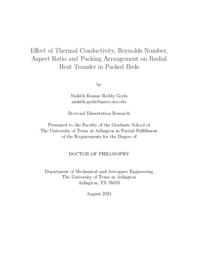
ATTENTION: The works hosted here are being migrated to a new repository that will consolidate resources, improve discoverability, and better show UTA's research impact on the global community. We will update authors as the migration progresses. Please see MavMatrix for more information.
Show simple item record
| dc.contributor.advisor | Dennis, Brian | |
| dc.creator | Gorla, Nishith | |
| dc.date.accessioned | 2023-06-27T23:39:21Z | |
| dc.date.available | 2023-06-27T23:39:21Z | |
| dc.date.created | 2021-08 | |
| dc.date.issued | 2021-08-10 | |
| dc.date.submitted | August 2021 | |
| dc.identifier.uri | http://hdl.handle.net/10106/31344 | |
| dc.description.abstract | The key motivation for this research is to study heat transfer developments in packed beds. The radial heat transfer enhancement of a packed bed in the laminar flow region is one of the major areas of ongoing research in mechanical, aerospace and chemical industries, especially the response of a packed bed during conjugate heat transfer with the fluid-solid interaction. This computational study focuses on the impact of packing size, thermal conductivity, and arrangement on the radial heat transfer performance as a function of Reynolds number. A simple annular tube packed with circles (2D) and spheres (3D) is utilized for this study. The heat transfer performance is quantified by an Effective Thermal Conductivity (ETC), which indicates the overall effectiveness of the radial heat transfer performance. The studies focus on laminar flow since many applications using packed beds involve slow moving fluids to avoid large pressure drops. Preliminary work focused on building an acceptable understanding of the problem in 2D before committing to time consuming 3D runs. A 2D rectangular packed bed is filled with different aspect ratios (tube to particle diameter ratio; 1 < Λ < 10) and different porosity of circular particles to see how radial heat transfer is affected by these parameters. Two packing styles (regular & staggered) are designed to compare the effect of packing structure on ETC. Similarly, a 3D cylindrical packed bed is a packed bed filled with spherical particles of different aspect ratios (2 < Λ < 10), different heater temperatures and two packing structures (radial & hollow) to see how these parameters effect ETC. Steady-state conjugate heat transfer analysis is performed for different values of parameters. The simulations are done for different packing materials in non-stagnant laminar flow conditions (ReP < 10) and the effects of Reynolds number and differing thermal conductivity of the materials on radial heat transfer is recorded. Periodic boundary conditions are imposed at the inlet and outlet.The simulations are run in COMSOL Multiphysics and, the Non-isothermal flow solver is used to couple the physics between the heat transfer and the fluid flow. Results obtained show that radial thermal conductivity greatly relies on the particle size and packing arrangement in 2D packing. The staggered packing of aluminum circles with the aspect ratio(Λ) of 3.39 produces highest radial thermal conductivity while regular packing of aluminum circles with the aspect ratio of 3.21 produces highest radial thermal conductivity.The staggered packing of wood particles with the aspect ratio of 3.39 has the similar radial thermal conductivity of the regular packing of aluminum circles with the aspect ratio of 1.07. In a 3D packed bed, ETC depends on heater temperature, thermal conductivity of a material, aspect ratio and packing arrangement. The ETC varies with thermal conductivity for different heater temperatures. The aspect ratio of 5.466 with radial packing of aluminum particles produces highest Ke Kf of 7.5. Whereas hollow packing of aluminum particles with aspect ratio of 2.733 producing highest Ke Kf of 6.5 for all heater temperatures. The radial heat transfer remains constant by increasing the Reynolds number within the laminar flow region (ReP < 10) for each aspect ratio, heater temperature, material and packing style. | |
| dc.format.mimetype | application/pdf | |
| dc.subject | Packed beds | |
| dc.subject | Radial heat transfer | |
| dc.subject | Effective thermal conductivity | |
| dc.subject | Packing arrangement | |
| dc.subject | Packed bed aspect ratio | |
| dc.subject | Packing material shape | |
| dc.subject | Reynolds number | |
| dc.title | EFFECT OF THERMAL CONDUCTIVITY, REYNOLDS NUMBER, ASPECT RATIO AND PACKING ARRANGEMENT ON RADIAL HEAT TRANSFER IN PACKED BEDS | |
| dc.type | Thesis | |
| dc.date.updated | 2023-06-27T23:39:21Z | |
| thesis.degree.department | Mechanical and Aerospace Engineering | |
| thesis.degree.grantor | The University of Texas at Arlington | |
| thesis.degree.level | Doctoral | |
| thesis.degree.name | Doctor of Philosophy in Aerospace Engineering | |
| dc.type.material | text | |
| local.embargo.terms | 2023-08-01 | |
| local.embargo.lift | 2023-08-01 | |
Files in this item
- Name:
- GORLA-DISSERTATION-2021.pdf
- Size:
- 5.468Mb
- Format:
- PDF
This item appears in the following Collection(s)
Show simple item record


